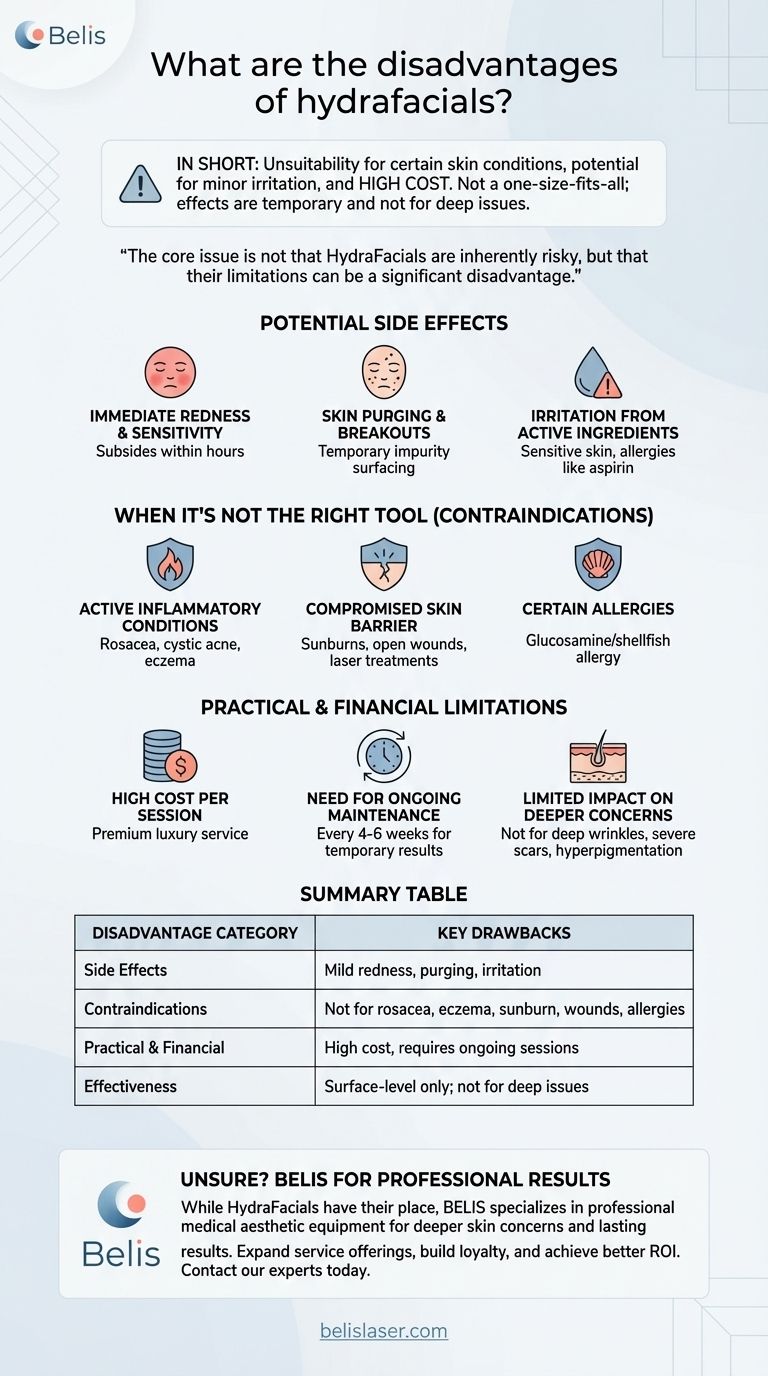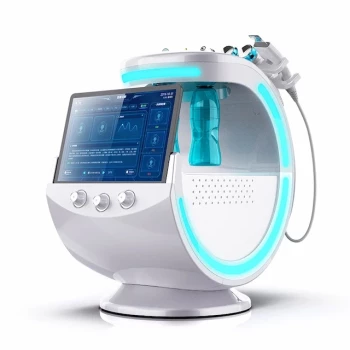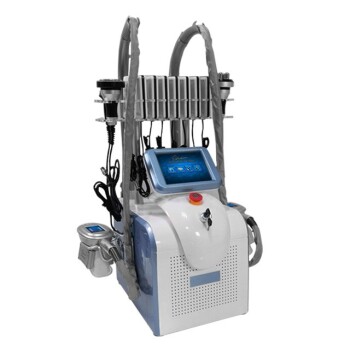In short, the primary disadvantages of a HydraFacial are its unsuitability for certain skin conditions, the potential for minor irritation, and its high cost. While generally very safe, it is not a one-size-fits-all solution. Its effects are also temporary, requiring consistent and costly treatments to maintain results, and it is not designed to address deeper dermatological issues like significant scarring or deep wrinkles.
The core issue is not that HydraFacials are inherently risky, but that their limitations can be a significant disadvantage. The main drawbacks are less about direct harm and more about practical considerations: its high cost, the need for repeated sessions, and its ineffectiveness—or potential for irritation—on specific skin types and conditions.

A Closer Look at Potential Side Effects
While marketed as a gentle, "no downtime" procedure, a HydraFacial is still an active treatment that manipulates the skin. Understanding the potential reactions is key.
Immediate Redness and Sensitivity
The most common side effect is mild redness immediately following the procedure. This is a normal reaction to the combination of suction from the vortex tip and the active exfoliating ingredients in the serums. For most people, this subsides within an hour or two.
Skin Purging and Breakouts
In some cases, especially for those with congested skin, a HydraFacial can bring underlying impurities to the surface. This process, known as skin purging, can result in temporary breakouts in the days following the treatment. While this is a sign the treatment is working, it can be an unwelcome short-term disadvantage.
Irritation from Active Ingredients
The treatment uses serums containing active ingredients like salicylic and glycolic acids. While the concentrations are generally low, individuals with highly sensitive skin or specific allergies (such as an allergy to aspirin, which is related to salicylic acid) may experience irritation or an allergic reaction.
When a HydraFacial Is Not the Right Tool
The most significant disadvantage of a HydraFacial is that it is contraindicated for several skin conditions. Attempting the treatment in these scenarios can worsen the existing problem.
For Active, Inflammatory Conditions
A HydraFacial should be avoided if you have active and inflamed skin issues. This includes chronic or flaring rosacea, cystic acne, active rashes, or eczema on the face. The stimulation and exfoliation can increase inflammation and aggravate these conditions.
For a Compromised Skin Barrier
The treatment is not suitable for skin that is already compromised. This includes skin with open wounds, cuts, sunburns, or areas recovering from recent laser treatments. The exfoliation and suction can impede healing and cause significant irritation.
If You Have Certain Allergies
Beyond the ingredients in the serums, a key component of the treatment tip is glucosamine. Individuals with a shellfish allergy are often advised to avoid HydraFacials, as this ingredient can potentially trigger a reaction.
Understanding the Practical and Financial Limitations
For many, the most prohibitive disadvantages are not related to skin reactions but to cost and effectiveness for long-term goals.
The High Cost of a Single Session
HydraFacials are a premium service. A single session can be expensive, positioning it as a luxury treatment rather than an accessible routine for everyone.
The Need for Ongoing Maintenance
The glowing, hydrated results of a HydraFacial are temporary. To maintain the benefits, professionals recommend treatments every 4-6 weeks. This transforms a one-time splurge into a significant and ongoing financial commitment.
Limited Impact on Deeper Skin Concerns
A HydraFacial is a surface-level treatment. It excels at improving hydration, radiance, and clearing minor congestion. However, it is not an effective solution for deep wrinkles, significant acne scarring, or severe hyperpigmentation. For these concerns, more intensive treatments like microneedling, chemical peels, or laser therapy are required.
Is a HydraFacial a Disadvantage for Your Goal?
To make the right choice, you must align the tool with your objective.
- If your primary focus is immediate radiance for an event: It is an excellent choice, provided you schedule it a couple of days in advance to account for any potential redness.
- If your primary focus is managing mild dullness and congestion: It is highly effective, but you must be prepared for the recurring cost to maintain results.
- If your primary focus is treating rosacea, severe acne, or deep scars: A HydraFacial is the wrong tool and could be a disadvantage; a consultation with a board-certified dermatologist is the necessary next step.
Ultimately, understanding a treatment's limitations is just as important as understanding its benefits.
Summary Table:
| Disadvantage Category | Key Drawbacks |
|---|---|
| Side Effects | Mild redness, potential for skin purging/breakouts, irritation from active ingredients. |
| Contraindications | Not suitable for active rosacea, eczema, sunburn, open wounds, or shellfish allergies. |
| Practical & Financial | High per-session cost, requires ongoing treatments (every 4-6 weeks) to maintain results. |
| Effectiveness | Surface-level treatment; not effective for deep wrinkles, severe scarring, or significant hyperpigmentation. |
Unsure if a HydraFacial is right for your clinic or salon?
While HydraFacials have their place, achieving lasting results for clients often requires more advanced, professional-grade technology. BELIS specializes in professional medical aesthetic equipment designed to address a wider range of skin concerns with greater efficacy.
We help medical aesthetics clinics and premium beauty salons:
- Expand service offerings with equipment for deeper skin rejuvenation.
- Deliver more significant, lasting results to build client loyalty.
- Invest in durable, advanced technology that provides a better return on investment.
Let's discuss the right equipment for your business goals. Contact our experts today for a personalized consultation.
Visual Guide

Related Products
- Hydrafacial Machine Facial Clean Face and Skin Care Machine
- Hydrofacial Machine with Facial Skin Analyzer and Skin Tester
- Hydrafacial Machine with Facial Skin Analyzer Skin Tester
- 4D 12D HIFU Machine Device for Skin Tightening and Lifting
- 12D HIFU Machine Device for Facial HIFU Treatment
People Also Ask
- What is the disadvantage of HydraFacial? Why the Results Are Temporary
- What are the negatives of HydraFacial? Potential Risks for Sensitive and Acne-Prone Skin
- Can anyone do a HydraFacial? Understanding Suitability for Your Skin
- What does hydro do for your face? Achieve Deep Hydration and Radiant Skin
- What is the difference between HydraFacial and manual facial? Choose the Right Treatment for Your Skin



















